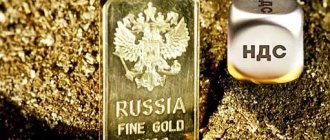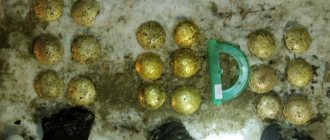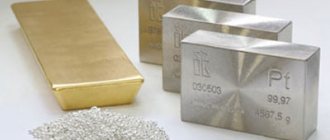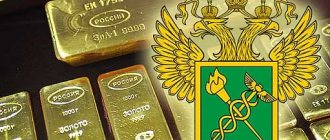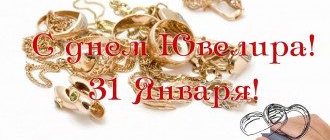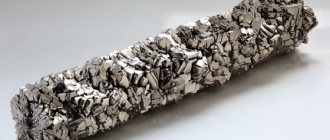This is common practice because... The enterprise records the amount of precious metals listed in passports, forms, certificates, but does not take into account losses during their use, replacement of parts, etc. Also, the manufacturer of any parts containing precious metals, having found a more cost-effective replacement for them, often forgets to change the passport data on the product or does not do this intentionally, because does not want to “interfere” with the procedure for changing GOST and, in fact, precious metals that do not end up in products are listed at the enterprise purchasing such products.
The legislator provided for these discrepancies in clause 6.20. Instructions “On the procedure for accounting and storage of precious metals, precious stones, products made from them and maintaining records during their production, use and circulation” approved by Order of the Ministry of Finance of the Russian Federation No. 68n dated August 29, 2001, which reads verbatim: “Accounting of the delivery organization scrap and waste compares the amount of precious metals in these raw materials with the passport data of refining organizations and, if there are discrepancies, finds out their reasons. Based on the results of the comparison, the necessary adjustments are made to the accounting and reporting documents. At the same time, the initial information about the amount of precious metals contained in scrap and waste is corrected. Corrections are made by crossing out the original entries and adding new entries above the crossed out entries. New entries on registered and shipped precious metals are made on the basis of passport data of processing enterprises.”
Of course, cases of theft of scrap and waste from the scrap delivery company cannot be ruled out.
In practice, it looks something like this: The scrap delivery company, having received a Calculation Passport from the processing company, compares the values of the listed precious metals in the delivered scrap and the confirmed data. In case of discrepancies (discrepancies are mandatory, it cannot be otherwise, the type of scrap and the magnitude of the discrepancies should be taken into account, for example, for radio-electronic scrap, discrepancies of up to 90% of the declared data are permissible, and for laboratory platinum glassware, discrepancies of 1% are no longer permissible), accounting the scrap delivery company makes a written request to the processing company with a request to explain the discrepancies that have arisen. The processing company responds to the request in writing. A written response and request is attached to the Passport-Calculation and this will be sufficient for the State Assay Supervision Inspectorate during verification. It is sufficient if the transaction was made with an enterprise producing or refining precious metals; in transactions with other processors, a copy of the Passport of Settlement of the producing or refining enterprise at which the processing of the delivered scrap was completed is required, with a copy of the agreement attached.
Legal basis for the sale of precious stones
Precious stones are of great importance for the economy of the Russian Federation, since they serve as one of the means of replenishing the country’s gold and foreign exchange reserves - the State Fund of Precious Metals and Precious Stones, the Diamond Fund - and, as a consequence of this, determine the country’s place in the world community, as well as its stability in conditions of the financial and economic crisis. At the same time, the circulation of precious stones makes it possible to significantly increase the budget revenue due to incoming tax deductions. Therefore, taking into account the importance of precious stones, the state must provide a decent legal basis and protection of these values from illicit trafficking, starting from the moment of their extraction.
Currently, the legislation does not have a single normative and legal act that would establish clear rules for the circulation of precious stones on the territory of the Russian Federation. When determining the legality of the circulation of these values, it is necessary to refer to a number of norms enshrined in legal documents of various levels, which causes certain difficulties for the law enforcement officer. For assistance in legal support of the organization’s activities, please contact our specialists.
The main document regulating relations relating to the extraction, use, circulation (circulation, sale) of precious stones on the territory of the Russian Federation is the Federal Law of March 26, 1998 No. 41 - Federal Law “On Precious Metals and Precious Stones” (hereinafter referred to as the “Law on Precious Stones”) stones").
Article 1 of the Law on Precious Stones defines precious stones, according to which they are understood as natural diamonds, emeralds, rubies, sapphires and alexandrites, as well as natural pearls in raw (natural) and processed form. In addition, unique amber formations can be classified as precious stones in the manner established by the Government of the Russian Federation. The list of precious metals is exhaustive and can only be changed by federal law.
As can be seen from the content of this definition, the legislator has chosen an easier way of forming it, namely, compiling a list of precious stones. However, this method is not perfect, since the science of precious stones (gemmology) does not stand still, and the practice of handling gems confirms that, along with the stones named in the Law on Precious Stones, other stones can be equated to precious stones (for example , especially valuable varieties of jade).
At the same time, it should be noted that the application of the procedure for classifying unique amber formations as precious stones, approved by Decree of the Government of the Russian Federation of January 5, 1999 No. 8, (hereinafter referred to as the Procedure) also allows us to talk about significant shortcomings of this document.
According to the provisions of the Procedure, by an expert commission formed under the Ministry of Finance of the Russian Federation, unique amber formations selected by mining organizations that meet the following criteria can be classified as precious stones:
“weight - over 1000 grams;
form - varied, fantasy, associated with the conditions of intra-stem formation of amber;
integrity - relatively monolithic in structure (at least 80 percent), without through holes or visual cracks that threaten the integrity of the sample;
inclusions - transparent samples with well-preserved inclusions of flora and fauna measuring more than 10 mm;
color - the varied range of colors inherent in amber.”
Based on the results of consideration of unique amber formations by an expert commission under the Ministry of Finance of the Russian Federation, a decision is made in the form of a protocol.
Based on the foregoing, it follows that unique amber formations that have the characteristics outlined in the Procedure “become” precious stones not from the moment of their extraction, but only after their selection by the mining organization and subsequent recognition as such by an expert commission under the Ministry of the Russian Federation. At the same time, the Procedure names only the protocol of the expert commission of the Ministry of Finance of the Russian Federation as a document confirming the classification of unique amber formations as precious stones. The issuance of passports and certificates for these amber formations is not provided.
In our opinion, the presence of a time interval between the direct discovery of unique amber formations and the decision to recognize them as precious stones actually creates “favorable ground” for conducting activities related to “illegal trafficking (circulation)” of these stones on “legal terms.” Thus, Article 191 of the Criminal Code of the Russian Federation provides for liability for “conducting a transaction related to precious metals, natural precious stones or pearls, in violation of the rules established by the legislation of the Russian Federation, as well as illegal storage, transportation or shipment of precious metals, natural precious stones or pearls in any form or condition, with the exception of jewelry and household items and scrap of such items.” From the disposition of the article it is clear that the object of the offense is the established procedure for the circulation of precious metals, precious stones, pearls, and one of the objects of the offense is precious stones. Accordingly, in order to bring a person to criminal liability for illegal trafficking in precious stones, it is necessary to prove that the person made transactions with precious stones, and these transactions were made in violation of the rules established by the legislation of the Russian Federation.
In the case of transactions with unique amber formations, the difficulty of proving is that if a person made transactions with them before the protocol was drawn up by the expert commission of the Ministry of Finance of the Russian Federation, then at the time of their execution the unique amber formations were not legally considered precious stones. Accordingly, we can talk about the absence of the subject of the offense.
Based on clause 2 of Art. 20 of the Law on Precious Stones it follows that during mining, use, circulation (conducting transactions), precious stones are subject to mandatory accounting by weight and quality. However, again, the specifics of recognizing unique amber formations as precious stones allows us to conclude that unique amber formations are subject to registration not from the moment of extraction, but only after the expert commission of the Ministry of Finance of the Russian Federation has drawn up a protocol. Therefore, it cannot be unequivocally stated that a person who made transactions with unique amber formations without maintaining mandatory records of these transactions before drawing up the corresponding protocol violated the rules for the circulation of precious stones established by the legislation of the Russian Federation, that is, we can talk about the absence in the actions of the person of the offense provided for Art. 191 of the Criminal Code of the Russian Federation.
Characterizing the Decree of the Government of the Russian Federation of January 5, 1999 No. 8 as a whole, it is also worth noting that it does not contain a clear mechanism for classifying unique amber formations as precious stones and does not establish what guides the expert commission under the Ministry of Finance of the Russian Federation in its work to determine the presence (lack of) criteria for classifying unique amber formations as precious stones.
Taking into account all of the above regarding the current definition of precious stones, it seems logical to conclude that fundamental changes to its content are simply necessary. At the same time, we believe that the definition of precious stones should include specific criteria and characteristics that allow stones to be recognized as precious from the moment they are discovered (mined).
By virtue of the provisions of Art. 1 of the Law on Precious Stones, “circulation” is one of the types of operations carried out with precious stones, and represents actions expressed in the transfer of ownership and other property rights to precious stones, including their use as collateral. The circulation of precious stones must be carried out in the manner and under the conditions established by the Law on Precious Stones and the legislation of the Russian Federation (clause 1 of Article 22).
As one of the entities that have the right to circulate (sell) precious stones, the law names organizations engaged in their extraction, that is, the extraction of precious stones from primary, alluvial and technogenic deposits, as well as sorting, primary classification and primary evaluation of precious stones. Extraction of precious stones must be carried out on the basis of a license for the use of subsoil in accordance with the Law of the Russian Federation of February 21, 1991 No. 2395-1 “On Subsoil” (clause 1 of Article 4 and Article 15 of the Law on Precious Stones). Precious stones extracted from the subsoil are the property of gemstone mining entities, unless otherwise established by licenses for their extraction, supply agreements, including agreements for the supply of products for federal needs, concluded with the participation of these entities, as well as international treaties of the Russian Federation (Article 4 Gem Law).[
In accordance with paragraph 6 of Art. 2 of the Law on Precious Stones, owners of precious stones exercise their right of ownership of precious stones, guided by the restrictions established by the Law on Precious Stones and the Civil Code of the Russian Federation, and owners of precious stones recognized as unsuitable for the manufacture of jewelry in the manner established by the Decree of the Government of the Russian Federation dated 23.11 .1998 No. 1365 “On the criteria and procedure for classifying precious stones as unsuitable for the manufacture of jewelry” - without the restrictions provided for by the Law on Precious Stones.
Considering that, depending on the results of the procedure for determining the suitability (unsuitability) of precious stones for the manufacture of jewelry, the further legal framework for regulating relations with precious stones is determined, we consider it appropriate to dwell in more detail on the provisions of the above resolution.
By virtue of clause 1 of this document, “The main criteria for classifying jewelry from precious stones (diamonds, rubies, sapphires, emeralds and alexandrites) as unsuitable for the manufacture of jewelry are their size, weight, color and quality characteristics, as well as the economic feasibility of their processing at enterprises cutting industry of the Russian Federation." In addition, it has been established that “natural diamonds unsuitable for making jewelry include natural diamonds in raw (natural) and processed form of sieve classes “-3+2” and below, including:
diamonds recovered from multicrystal diamond tools;
waste from any type of diamond processing;
diamond concentrate;
diamond chips and diamond powders.”
Natural diamonds with edge and drill shapes are also considered unsuitable for making jewelry, regardless of their characteristics and degree of processing.
The classification of precious stones as unsuitable for the manufacture of jewelry is carried out by organizations that carry out the primary classification of precious stones, based on the results of mandatory sorting and evaluation. These organizations are required to issue documents of the established form (passports or certificates) for precious stones that they classify as unsuitable for the manufacture of jewelry (clause 3).
Based on the content of these provisions, it follows that the Government of the Russian Federation uses a narrower concept of precious stones than that provided for by the Law on Precious Stones. In particular, there is no mention of “natural pearls in raw (natural) and processed forms.” Therefore, it is assumed to be a logical conclusion that pearls in any form cannot be classified as unsuitable gemstones for making jewelry, which, in turn, is the basis for the following conclusion: owners of pearls can exercise ownership rights only subject to the restrictions established Law on Precious Stones.
The Government of the Russian Federation provides relatively detailed criteria for classifying diamonds as unsuitable for making jewelry. In relation to other precious stones (rubies, sapphires, emeralds, alexandrites), only an abstract rule is established for determining the unsuitability of such precious stones for making jewelry.
According to clause 2 of the considered Resolution of the Government of the Russian Federation, the Ministry of Finance of the Russian Federation was instructed to establish, in agreement with the Ministry of Economy of the Russian Federation, on the basis of existing classifiers, the maximum characteristics of precious stones (diamonds, rubies, sapphires, emeralds and alexandrites), on the basis of which the economic inexpediency of their processing at enterprises is determined cutting industry of the Russian Federation.
However, to date this instruction has not been implemented in full. The limiting characteristics on the basis of which the economic inexpediency of processing precious stones at cutting industry enterprises is determined are established only for diamonds.
The shortcomings and gaps in the Decree of the Government of the Russian Federation of November 23, 1998 No. 1365 “On the criteria and procedure for classifying precious stones as unsuitable for the manufacture of jewelry” actually indicate the failure of the Government of the Russian Federation to fulfill the obligation assigned to it by the Law on Precious Stones to establish criteria for classifying precious stones as unsuitable for the manufacture of jewelry, and the Ministry of Finance of the Russian Federation, is responsible for determining the limiting characteristics of precious stones (rubies, sapphires, emeralds and alexandrites), on the basis of which the economic inexpediency of their processing at cutting industry enterprises of the Russian Federation is determined.
The mentioned legal shortcomings, in our opinion, allow subjects of precious stones mining to unreasonably classify precious stones (rubies, sapphires, emeralds and alexandrites) as unsuitable for the manufacture of jewelry in order to exclude the application to the circulation of precious stones of the restrictions established by the Law on Precious Stones, and create preconditions for the implementation of “illegal” trafficking in precious stones.
By virtue of clause 5 of Art. 2 of the Law on Precious Stones, mining entities are obliged, when selling extracted precious stones in sorted form, to offer them for purchase in priority order: 1) to the Ministry of Finance of the Russian Federation to replenish the State Fund of Precious Metals and Precious Stones of the Russian Federation; 2) authorized executive authorities of the constituent entities of the Russian Federation, in the territories of which these precious stones were mined, to replenish the corresponding state funds of precious metals and precious stones of the constituent entities of the Russian Federation. It is worth noting that the pre-emptive right to purchase precious stones arises from the listed bodies under the conditions of preliminary conclusion with the mining entities of purchase and sale agreements for precious stones and making advances against payments due under these agreements. The same pre-emptive right to purchase the above bodies is enshrined in clause 4 of Art. 20 of the Law on Precious Stones in relation to nuggets of precious stones classified as unique. At the same time, according to clause 2 of the Government of the Russian Federation of September 22, 1999 No. 1068 “On the procedure and criteria for classifying nuggets of precious metals and precious stones as unique,” nuggets of precious stones that meet the criteria set out in this paragraph must be selected and submitted to expert commissions on certain types of precious stones of the Ministry of Finance of the Russian Federation. Based on the results of the examination, the relevant expert commission makes a decision to classify (refuse to classify) nuggets of precious stones as unique. For unique nuggets of precious stones, expert commissions draw up documents confirming the fact that they are classified as unique, and they are subject to special accounting.
It is necessary to note that the general provisions regarding the procedure for classifying nuggets of precious stones as unique also have legal shortcomings. In particular, in paragraph 2 of the Decree of the Government of the Russian Federation of September 22, 1999 No. 1068, a “diamond weighing 20 carats or more” is defined as a nugget of precious stones separately from diamonds, which: 1) does not correspond to the definition of precious stones set out in the Law on Precious Stones stones; 2) seems contradictory when compared with the requirement of this document to recognize nuggets of precious stones as unique before they enter circulation, since already processed natural diamonds of various cut shapes with polished edges are recognized as diamonds. In addition, among the list of precious stones that can be recognized as unique, other cut precious stones (rubies, sapphires, etc.) are also mentioned, which also, in our opinion, does not comply with the provisions of the resolution on the procedure for recognizing nuggets of precious stones unique.
In addition, as another legal flaw in the procedure for recognizing nuggets of precious stones as unique, it is worth noting the presence in the legal system of the Russian Federation of actually two existing documents regulating the status of expert commissions (expert subcommittees) of the Ministry of Finance of the Russian Federation, carrying out an examination of classifying nuggets of precious stones as unique:
1) Order of the Ministry of Finance of the Russian Federation dated 03/09/2000 No. 65 “On approval of regulations on expert commissions of the Ministry of Finance of the Russian Federation for classifying jewelry, nuggets of precious metals and precious stones and their compositions as unique”;
2) Order of the Ministry of Finance of the Russian Federation dated June 16, 2004 No. 51n “On approval of the regulations on the expert commission of the Ministry of Finance of the Russian Federation.”
At the same time, the functions and tasks of expert commissions (expert subcommittees) of the Ministry of Finance of the Russian Federation, established by these documents, are duplicated.
In accordance with paragraphs. 4, 5 tbsp. 20 of the Law on Precious Stones, nuggets not purchased by the State Fund of Precious Metals and Precious Stones of the Russian Federation are returned to the subjects of their extraction or are sold on behalf of the specified subjects of the extraction of precious stones, including at auction. Precious stones not sold as a priority, including those who choose not to purchase unique precious metal nuggets, may be:
- sold by the subjects of their production to any legal entities and individuals, including through precious metals and precious stones exchanges operating in the Russian Federation;
— used in their own production or as a subject of collateral or other financial obligation;
- and also exported from the territory of the Russian Federation for sale on the foreign market in accordance with the Regulations on the procedure for import into the customs territory of the Customs Union within the EurAsEC and export from the customs territory of the Customs Union within the EurAsEC of precious metals, precious stones and raw materials containing precious metals , approved by the Decision of the Board of the Eurasian Economic Commission.
The interpretation of these rules in conjunction with the interpretation of the rules of Article 2 of the Law on Precious Stones (on the ownership of precious stones) allows, in addition to mining entities, to identify such entities for the sale of precious stones as:
1) any legal entities and individuals;
At the same time, based on the content of Art. 10 and Art. 13 of the Law on Precious Stones, legal entities and individual entrepreneurs carrying out transactions with precious stones, including their sale (circulation), are subject to special accounting.
According to clause 3 of the Instruction on the procedure for maintaining special records of organizations and individual entrepreneurs carrying out operations with precious metals and precious stones (approved by Order of the Ministry of Finance of the Russian Federation dated June 16, 2003 No. 51 n), organizations are subject to special records, regardless of their legal form , including those under the jurisdiction of federal executive authorities, which provide for military service, and individual entrepreneurs extracting (including incidentally), producing, processing, processing and using precious stones in production, scientific, military, medical, educational and for socio-cultural purposes, using as collateral or accepting as collateral, purchasing, trading, exhibiting, storing, transporting precious stones, as well as procuring, performing primary processing and/or processing the prepared waste of precious stones.
Special accounting is carried out by the Russian State Assay Chamber under the Ministry of Finance of the Russian Federation through state inspections of assay supervision. Organizations and individual entrepreneurs, before carrying out transactions with precious stones, are specially registered with those state inspectorates of the Russian State Assay Chamber in the area of operation of which they have passed state registration.
Organizations and individual entrepreneurs that purchase and/or use precious stones classified as unsuitable for making jewelry are not subject to special registration.
With regard to individuals, as subjects of the sale of precious stones, it is worth noting that the Law on Precious Stones does not contain any rules, prohibitions or restrictions regarding the procedure for individuals to carry out transactions involving the circulation of precious stones, both raw and processed.
However, the norms of clause 61 of the Rules for the sale of certain types of goods approved by Decree of the Government of the Russian Federation of January 19, 1998 No. 55, clause 1 of Decree of the Government of the Russian Federation of April 5, 1999 No. 372 “On the certification of precious metals, precious stones and products made from them” , All-Russian Product Classifier. OK 005-93 (approved by Decree of the State Standard of Russia dated December 30, 1993 No. 301) allow us to conclude that when selling cut diamonds made from natural diamonds and cut emeralds, individuals must have a certificate for each stone or set ( batch) of stones sold. In relation to the sale by individuals of sapphires, rubies, alexandrites and pearls, both processed and untreated, as well as rough diamonds and emeralds, these documents do not provide for rules on the need for a certificate.
At the same time, in law enforcement practice, situations often arise when individuals are trying to be held criminally liable for transactions for the purchase and sale of sapphires, rubies, alexandrites and pearls, as well as rough diamonds and emeralds (not recognized as unsuitable for making jewelry) due to lack of appropriate certificates. In this case, the justification is given by reference to the norm of paragraph 2 of Art. 20 of the Law on Precious Stones, which establishes the rule that “precious stones are subject to mandatory accounting by weight and quality during mining, production, use and circulation” in the manner established by the Government of the Russian Federation.
In our opinion, this position seems controversial. Based on the literal interpretation of the law, it follows that the circle of subjects to whom its action extends is not defined. Turning to clause 2 of the Rules for accounting and storage of precious metals, precious stones and products made from them, as well as maintaining relevant reporting, approved by Decree of the Government of the Russian Federation of September 28, 2000 No. 731, it can be determined that these Rules apply only to legal entities including military units and military formations, and citizens registered in the prescribed manner as individual entrepreneurs operating in the field of extraction, production, use and circulation of precious metals and precious stones, collection, procurement, primary processing and processing of scrap and precious waste metals and precious stones recovery, as well as those using products containing precious metals and precious stones. In addition, the above Rules do not speak at all about certificates for precious stones.
Considering the above, it seems logical to conclude that the Rules do not apply to citizens who are not registered as an individual entrepreneur and who do not carry out entrepreneurial activities, as well as stateless persons and foreign citizens. That is, the listed persons have the right to carry out individual transactions, including the purchase and sale of sapphires, rubies, alexandrites and pearls, both processed and unprocessed, as well as rough diamonds and emeralds, in the absence of a certificate and without carrying out their mandatory accounting.
Such “loopholes” in the legislation create, in our opinion, obstacles in bringing individuals actually involved in the illegal trafficking of precious stones to criminal liability.
2) exchanges;
By virtue of the provisions of Article 3 of the Law on Precious Stones, in the Russian Federation there are exchanges of precious metals and precious stones intended for legal entities and individuals to carry out transactions related to the circulation of: a) unprocessed precious stones that have been sorted; b) processed precious stones; c) products made of precious metals and precious stones, with the exception of jewelry and other household products made of precious metals and precious stones.
Taking into account the specifics of the turnover (sale) of precious stones, as well as the lack of a regulatory act regulating in detail the procedure for transactions with precious stones on the exchanges of the Russian Federation by legal entities and individuals, we believe that it is necessary to take measures aimed at developing this kind of document.
As can be seen from the analysis of all the above regulatory and legal acts, despite their imperfections, at present, of the entire list of precious stones, the state, represented by its legislative and executive authorities, has most carefully resolved issues relating to the circulation (sale) of diamonds on the domestic market.
It is worth noting that the Russian Federation plays a significant role in the fight against illegal circulation of diamonds on the foreign market. Thus, since July 2000, the Russian Federation joined the Kimberley Process and has since taken an active part in its work. At its core, the Kimberley Process is a permanent interstate conference in which countries producing and importing diamonds take part. The purpose of creating this conference was the need to develop at the level of the world community a mechanism to prevent the sale of so-called “blood” or “conflict” diamonds used to arm and support anti-government and terrorist organizations.
One of the measures taken as part of the Kimberley Process and aimed at eliminating the possibility of diamonds mined in armed conflict zones and illegally put into circulation entering into the normal (legal) trade turnover is the Certification Scheme, which came into force on January 1, 2003. The certification scheme actually includes 3 main aspects:
1) each batch of rough natural diamonds when crossing the border of countries participating in the Kimberley Process must be accompanied by a national certificate;
2) in each country participating in the Kimberley Process, a system of internal national control should be created in order to prevent “conflict” diamonds from entering the “mining - sorting - export” or “import - cutting - sales” chain;
3) each country participating in the Kimberley Process must provide annually statistical data on the production, export, import of rough diamonds, as well as information on changes in legislation, powers and structure of the bodies responsible for implementing the provisions of the certification system.
According to the Certification Scheme, countries participating in the Kimberley Process must verify (and ensure) the presence of a Kimberley Process certificate for all rough diamonds intended for export and import transactions between participating countries. At the same time, conditions must be created for the availability and safety of the original Kimberley Process certificates for at least 3 years.
Certificates are issued by the Kimberley Process office on the basis of a prescribed application submitted on behalf of the exporter or importer of raw materials. Each certificate contains a unique serial number, indicates the place of production and confirmation that there are no “conflict” diamonds in the parcel. The validity period of such a certificate is 90 calendar days, after which it becomes invalid.
In order to implement the main provisions of the Certification Scheme in the Russian Federation, the following measures have been taken: a) Decree of the Government of the Russian Federation dated 02/06/2003 No. 67 established a certificate for the export of rough natural diamonds, confirming their Russian origin; b) Decree of the Government of the Russian Federation dated August 27, 2003 No. 527 established a procedure according to which, when importing rough natural diamonds into Russia, the presence of a Kimberley Process certificate is checked; c) data on the production and trade of natural diamonds was declassified; d) The Ministry of Finance of Russia and the Ministry of Economic Development of Russia have established a procedure for publishing statistical data on the production of rough natural diamonds in the Russian Federation and export-import transactions with them.
Based on official data from the Kimberley Process, it follows that the introduction of the Certification Scheme has significantly reduced the scale of illicit trafficking in blood diamonds. At the same time, the practice of its use has also shown negative aspects. In particular, due to the different approaches of the participating countries to the issuance and use of a certificate in matters not specified in the Certification Scheme (the possibility of changing the delivery route, the presence of a tear-off return coupon for the certificate, the requirement to confirm delivery), obtaining accurate statistics has become difficult.
Summing up the legal analysis of the regulation of activities for the sale of precious stones, it is worth noting that the current legal acts were developed and adopted decades ago. During their existence and application, a number of significant shortcomings, contradictions, gaps and improvements have been identified that do not allow fully combating the illicit trafficking of precious stones. Considering the importance of precious stones for the economy of the Russian Federation, as well as the long-term negative impact on the economy of the Russian Federation of sanctions from Western countries and the European Union, we consider it necessary and urgent to carry out serious and significant work to improve existing legal acts in the field of circulation of precious stones and bring them into compliance correspondence.
Jewelry by law
Vladislav Dokuchaev,
methodological director of the educational project "Art Banking"
Legislative framework for the circulation of precious stones on the territory of the Russian Federation.
The Finversia.ru portal continues to publish a series of articles by Vladislav Dokuchaev, methodological director of the educational project “Art-banking”, the Institute of short-term programs at the Financial University under the Government of the Russian Federation and Anton Sorokin, chief expert of the “Art-banking” project, dedicated to the intricacies of investing in precious stones and products from them. The first part of the material can be found by following the link.
The previous article “In search of new investment objects in conditions of instability: precious stones as a defensive asset” aroused great interest among readers, so I would like to continue to consider precious stones as possible objects for investment.
First of all, it is necessary to dwell on the legislative framework that describes the investment objects themselves and establishes the procedure for their circulation on the territory of the Russian Federation. The basic document in this area is the Federal Law of March 26, 1998 No. 41-FZ (as amended on July 3, 2016) “On Precious Metals and Precious Stones.”
This law establishes that precious metals include gold, silver, platinum and platinum group metals (palladium, iridium, rhodium, ruthenium and osmium), and precious stones include natural diamonds, emeralds, rubies, sapphires and alexandrites, as well as natural pearls in raw (natural) and processed form. Unique amber formations are also considered precious stones. Separately, the law establishes that materials of artificial origin that have the characteristics (properties) of precious stones are not precious stones.
Please note that the list of precious stones is quite short, it is closed and the law especially emphasizes that any artificial formations cannot be called precious stones. Typically, the gemstones mentioned in the law are called gemstones of the first group, while the rest are called colored gemstones. It is also worth noting that the law does not contain the concept of diamond, since in the Russian tradition a diamond is the name of a cut diamond, so the legislation operates with a more general concept.
The next important concept that the law defines is the right of ownership of precious metals and precious stones. Note that the general approach to determining ownership of precious stones is based on the Constitution of Russia, the Civil Code of the Russian Federation and subsoil laws. Precious metals and precious stones extracted from the subsoil, as well as other products and income lawfully received during the extraction of precious metals and precious stones, are the property of the subjects of extraction of precious metals and precious stones, unless otherwise established by licenses for their extraction. It is especially emphasized that the owner of illegally mined precious metals and precious stones is the Russian Federation. The owners of legally mined precious metals and precious stones, as well as items and products made from them, can be legal entities and individuals who carry out their circulation, taking into account the requirements of the law.
In considering precious stones as investment objects, we will not dwell on the nuances of mining, sorting, evaluating and cutting precious stones - this topic is too extensive for one article. Let us consider only the features of the production and circulation of finished jewelry.
In the Russian Federation, jewelry and other products made of precious metals of domestic production and jewelry and other products made of precious metals imported into the Russian Federation for sale are subject to testing and stamping with a state hallmark. Branding of products of historical or archaeological significance, ingots of refined precious metals of domestic and foreign production, nuggets of precious metals, gold leaf, silver leaf, instruments, laboratory glassware and other products made from precious metals and intended for scientific, industrial and medical purposes is not carried out. goals. We emphasize that jewelry and other products made of precious metals of domestic production must have a name tag (manufacturer’s symbol), which are subject to registration.
Please note that the legislation of the Russian Federation does not provide for mandatory certification of precious stones. This nuance will be important when we move on to consider issues of the authenticity of precious stones, as well as their valuation.
Another important element of the system of circulation of precious stones in our country is assay supervision. Federal state assay supervision refers to the activities of the authorized federal executive body and state institutions subordinate to it, aimed at preventing, identifying and suppressing violations by legal entities and individual entrepreneurs engaged in the production, use, circulation of precious metals in any condition and form, sorting, primary classification and the initial evaluation of gemstones, their use and circulation. The authorized federal body is the Ministry of Finance of the Russian Federation.
An important element of the legislation of the Russian Federation in the field of precious metals and precious stones is the presence in the Criminal Code of Russia of Article 191. “Illegal trafficking in precious metals, natural precious stones or pearls.” In accordance with it, a transaction involving precious metals, natural precious stones or pearls is subject to criminal punishment, in violation of the rules established by the legislation of the Russian Federation, as well as illegal storage, transportation or transfer of precious metals, natural precious stones or pearls in any form , condition, with the exception of jewelry and household products and scrap of such products, committed in the amount of more than two and a half million rubles. Let us especially pay attention to the exception prescribed in this article of the Criminal Code - the turnover of jewelry does not fall under criminal regulation in any form.
Thus, having examined the main provisions of the legislation of our country, we can state that precious stones, as an object of investment, are described in sufficient detail, the procedure for their circulation is regulated, and property rights are based on general civil legislation.
Ownership of precious metals in impersonal form
UDC 347.23
Magazine pages: 86-90
M.A. ZINKOWSKY,
Candidate of Legal Sciences, Lecturer at the Department of Civil Law and Process, Belgorod State National Research University,
S.V. TYCHININ,
Doctor of Law, Professor, Head. Department of Civil Law and Procedure, Belgorod State National Research University [email protected]
The features of ownership of precious metals in impersonal form are considered.
Key words: ownership of precious metals in impersonal form; bars and coins made of gold, silver, platinum, palladium, iridium, rhodium, ruthenium and osmium.
The property right to precious metals in the depersonalized form
Zinkovsky M., Tychinin S.
The features of the right of ownership for the precious metals in aggregate form.
Keywords: the property right to precious metals in the depersonalized form; ingots and coins from gold, silver, platinum, a palladium, iridium, rhodium, ruthenium and osmium.
In civil transactions, contracts and transactions are quite rarely concluded, the subject of which are precious metals in an impersonal form, which increases scientific and practical interest in them. In the second paragraph of Art. 1 of the Federal Law of March 26, 1998 No. 41-FZ “On Precious Metals and Precious Stones”[1] establishes that precious metals include “gold, silver, platinum and platinum group metals (palladium, iridium, rhodium, ruthenium and osmium) . This list of precious metals can only be changed by federal law. Precious metals can be in any condition, form, including native and refined form, as well as in raw materials, alloys, semi-finished products, industrial products, chemical compounds, jewelry and other products, coins, scrap and industrial and consumer waste.”
Precious metals in an impersonal form are not things; they are accounted for in impersonal metal accounts for the execution of relevant contracts; it is advisable to call such objects “non-cash precious metals.” Along with precious metals in impersonal form, there are cash precious metals, which are things and are included in the same list of precious metals. Precious metals in impersonal form are specific objects of civil rights due to their high commodity value, monetary legal nature, chemical properties of the metal and rarity (including limited) use in civil circulation.
This article is an analysis of the main problems and features of ownership of precious metals in impersonal form. Fundamental works in this area include the works of such scientists as S.S. Alekseev, V.A. Alekseev, M.I. Braginsky, V.A. Belov, A.V. Venediktov, E.A. Emelyanova, S.A. Zinchenko, N.M. Korshunov, V.P. Kamyshansky, P.V. Krasheninnikov, T.V. Kiseleva, V.F. Maslov, E.V. Poluneeva, A.P. Sergeev, E.A. Sukhanov, K.I. Sklovsky, Yu.K. Tolstoy and others.
The science of civil law currently does not allow us to answer the question: does the owner of precious metals in an impersonal form have the classical triad of powers - possession, use and disposal - as prescribed by paragraph 1 of Art. 209 of the Civil Code of the Russian Federation? To answer this question, it is necessary to clarify the legal nature of precious metals in impersonal form from the point of view of the proprietary or obligatory approach, and, more simply, to determine whether such metals are things or not.
In civil law there is no definition of the concept of precious metals in an impersonal form. They are called as such based on the name of the agreement on an impersonal metal account, which is opened for a client by a commercial bank to carry out certain transactions.
In civil literature, the studied metals from the point of view of objects of civil rights are understood as things, incorporeal conditional precious metals (claim rights) and money.
A.Yu. Fedorov and I.P. Serebryakov believe that precious metals act as a material object of civil legal relations, i.e. things. At the same time, incorporeal conditional precious metals are rights of claim for the supply of precious metals[2].
In certain cases, for example, when purchasing coins made of precious metals by an individual from a commercial bank, precious metals are things and act in civil circulation as bars and coins, but the authors identify incorporeal conditional precious metals and define them as claims for the supply of precious metals. This statement is controversial for the following reasons.
Firstly, in a literal sense, incorporeal conventional precious metals are devoid of a physical external form, i.e. they are not things or, strictly speaking, “do not have their own body.” Then what are they and what do they represent in the relevant agreements, what is their legal nature?
Secondly, the term “incorporeal conventional precious metals” is unfortunate. It is not clear what the “conventionality” of metal is? It seems more appropriate to use the term “non-cash precious metals”. In support of this statement, an example should be given from the legislation of the Republic of Belarus. According to paragraph six of clause 1 of the Instructions for banks to carry out banking operations with precious metals (approved by Resolution of the Board of the National Bank of the Republic of Belarus dated December 10, 2004 No. 186), non-cash precious metals mean precious metals placed and accounted for in unallocated, deposit or deposit metal accounts [3]. The term “non-cash” exhaustively and consistently defines the nature of these metals; its meaning is that non-cash precious metals in civil circulation are not things. In the science of civil law, the term “non-cash” is also used in relation to money and is well-established.
Thirdly, the right of claim for the supply of precious metals is the right of one party under a supply agreement to demand the performance of certain actions from the other party, which exists in the delivery obligation. Law is a measure of the possible behavior of a party to a contract, the implementation of which in practice is sometimes relative. For example, the termination of an obligation due to the coincidence of the debtor and the creditor in one person (Article 413 of the Civil Code of the Russian Federation) or the impossibility of fulfillment (Article 416 of the Civil Code of the Russian Federation) are cases when a party to the contract cannot exercise such a right. A logical question follows from this: how can the right of claim be an incorporeal conditional precious metal? The right of claim is, rather, a feature of legal relations with precious metals, also inherent in other civil obligations where there is a debtor and a creditor.
S.I. Popova argues that, in general, precious metals in any form and condition as objects of civil legal relations are things. Moreover, as things they are characterized by generic characteristics, but under some conditions it can also be an individually defined thing (for example, a measured or standard gold bar, which has its own serial number, a refinery sign and other individual characteristics). Their uniqueness also lies in the fact that they can perform the functions of a measure, are the subject of investment, and are among the capital-intensive things, since, having a high cost per unit of volume, they are convenient for storage [4].
Regarding cash precious metals, one must agree with S.I. Popova is that such metals are things. As for precious metals in impersonal form, they cannot be things. The author, apparently, understands the monetary nature of precious metals by the functions of the yardstick, unfortunately, without arguing his position and without explaining whether she considers bars and coins money?
AND I. Kurbatov believes that precious metals are an independent object of rights and cannot be considered as a means of payment for two reasons: firstly, the use of these objects to repay a monetary obligation is permissible only with the consent of the creditor, for which it is required when settling civil obligations reaching an agreement between the parties, and in public cases - a direct indication in the legislation; secondly, the receipt of these objects by the creditor does not mean the automatic termination of a monetary obligation. In circulation, these objects are more often used as goods, i.e. they themselves are the subject of civil transactions[5]. The author proceeds from the fact that precious metals cannot be money. If we take into account bullion, then this statement seems justified, which cannot be said about coins. Unfortunately, A.Ya. Kurbatov does not divide precious metals into bars and coins in this matter.
It seems that the right of ownership of precious metals in an impersonal form has a number of features from the point of view of the science of civil law.
Monetary legal nature. Precious metals in impersonal form are impersonal while on the account, so it is impossible to say for sure whether it is money or bullion, and when the account is ultimately closed, the client can receive both in kind. The only fundamental question is that coins made of precious metals deposited into an impersonal metal account as things are money (non-cash money), i.e., legal tender on the territory of the Russian Federation, and then are transformed into the rights of claim of the client to the bank.
Legal obligations nature. The classic triad of owner rights: possession, use, disposal is not applicable to precious metals in an impersonal form, since they are not materialized and are rights of claim. In this regard, the point of view of E.V. deserves attention. Bogdanov, who believes that it is hardly possible to explain the relationship that develops between the client and the bank regarding funds from the standpoint of an elementary model of property rights. The scientist proposes to proceed from the position of divided ownership: the client is the supreme owner, and the bank is a subordinate[6]. A similar approach can also be applied to precious metals in impersonal form. Other scientists believe that after money is credited to the account, the client loses ownership of it and, accordingly, his property right is transformed into a liability[7]. In the science of civil law, there is a point of view according to which bank clients retain ownership of both cash and non-cash money[8]. V. Rakhmilovich takes a compromise position on this issue, arguing that no one has the right of ownership of non-cash money - neither the bank nor its clients, since there is no individualized property object, which is a necessary condition for the emergence and existence of the ownership right itself[9 ].
Limited turnover of precious metals due to insufficient regulatory regulation. It cannot be said that precious metals in general and precious metals in impersonal form in particular are objects of free civil circulation, which is confirmed by Articles 191 and 192 of the Criminal Code of the Russian Federation. It should also be borne in mind that precious metals may be partly limited in civil circulation due to their status as cultural values. Currently, a number of questions remain open in the science of civil law: can cultural values in the form of coins and bars be the subject of contractual obligations with precious metals in impersonal form[10]? Does the triad of owner rights apply to such cultural values: possession, use and disposal? Can cash and non-cash precious metals in the form of bars and coins even be cultural values? Among the civil works in this area are the fundamental scientific research of A.P. Sergeev, dedicated to the civil protection of cultural property[11].
To summarize the above, it should be pointed out that of the above points of view, the most correct one will be the one according to which, after crediting money (coins from precious metals, as well as bullions) to the account, the client loses ownership of them and, accordingly, his property right is transformed into a liability right. Here it is necessary to clarify that the client, after depositing cash precious metals (things) into a deposit or account, acquires the right to claim the bank for the return of the corresponding amount of metal and interest due (which has been repeatedly written about by such scientists as V.V. Vitryansky, L.A. Novoselova, E.A. Sukhanov, etc.) or an equivalent amount of money. The depositor cannot have a proprietary right to precious metals in an impersonal form, since the latter are not things.
Thus, the right of ownership of precious metals in an impersonal form cannot be considered from the position of the classical triad of powers - possession, use and disposal - since the studied objects of civil rights, by their legal nature, are rights of claim and have certain restrictions in civil circulation due to insufficient legal regulation.
Literature
Alekseev V.A. Real estate: legal regime and state registration of rights: abstract. dis. ... Doctor of Law. Sci. - M., 2008.
Alekseev S.S. Ownership. Problems of theory. 2nd ed., revised. and additional - M., 2007.
Belov V.A. Civil law: general and special parts: textbook. - M., 2003.
Venediktov A.V. State socialist property / resp. ed. VC. Ryhekr. - M., 1948.
Venediktov A.V. Civil protection of socialist property in the USSR. - M.; L., 1954.
Emelyanova E.A. Legal problems of state registration of rights to real estate and transactions with it: abstract. dis. ...cand. legal Sci. — Saratov, 2004.
Zinchenko S.A. State property in the USSR (economic and legal aspect): abstract. dis. ... Doctor of Law. Sci. - M., 1989.
Kamyshansky V.P. Legal regulation of the privatization of state and municipal enterprises and its effectiveness: abstract. dis. ...cand. legal Sci. - St. Petersburg, 1994.
Kiseleva T.V. Civil regulation of real estate: abstract. dis. ...cand. legal Sci. - M., 2007.
Commentary on the Civil Code of the Russian Federation (part one) / ed. HE. Sadikov. - M., 1997 (author of Chapter 5; Chapter 21; articles 309-316, 318-328, Chapter 22; articles 330-333, 359, 360, Chapter 23; Chapter 26 - M.I. Braginsky).
Korshunov N.M. Privatization process of the Russian Federation: methodology of legal regulation: abstract. dis. ... Doctor of Law. Sci. - M., 1998.
Krasheninnikov P.V. Modern problems of property rights and other property rights to residential premises: abstract of thesis. dis. ... Doctor of Law. Sci. - M., 1997.
Maslov V.F. The main problems of personal property rights during the construction of communism in the USSR. - Kharkov, 1950.
Mattei U., Sukhanov E. Basic provisions of property rights. - M., 1999.
Poluneeva E.V. Institute of state registration of rights to real estate and transactions with it (civil aspect): abstract. dis. ...cand. legal Sci. - M., 2004.
Sklovsky K.I. Current problems of property rights // Law. 2004. No. 2.
Sklovsky K.I. Problems of property and possession in Soviet civil law: abstract. dis. ... Doctor of Law. Sci. - M., 1999.
Sukhanov E.A. Lectures on property rights. - M., 1991.
Tolstoy Yu.K. Once again about forms of ownership in the Russian Federation // Jurisprudence. 1993. No. 3. P. 28-33.
Tolstoy Yu.K. To the doctrine of property rights // Jurisprudence. 1992. No. 1. P. 15-23.
Tolstoy Yu.K. Concept by A.V. Venediktova on property rights and modernity // Jurisprudence. 1988. No. 2. P. 15-27.
Tolstoy Yu.K. Property and property rights in the conditions of perestroika // Jurisprudence. 1990. No. 4. P. 3-15.
Bibliography
1 SZ RF. 1998. No. 13. Art. 1463.
2 See: Fedorov A.Yu. Precious metals as objects of civil legal relations under the legislation of the Russian Federation: dis. ...cand. legal Sci. - M., 2005. P. 37; Serebryakov I.P. Legal regulation of the turnover of precious metals // Current problems of civil law: collection. Art. edited by M.I. Braginsky. - M., 1998. P. 406.
3 URL: https://www.levonevski.net/pravo/kodeksy/gk/045.html (access date: 11/10/2007).
4 See: Popova S.I. Civil regulation of transactions with precious metals: dis. ...cand. legal Sci. - M., 2002. P. 81.
6 See: Kurbatov A.Ya. Bank accounts in Russian law: concept, types, legal regimes: dis. ...cand. legal Sci. - M., 2006. P. 17-18.
7 See: Bogdanov E.V. Issues of ownership in the activities of banks // Materials of the regional interuniversity. scientific-practical conf. March 19-20, 1998 “Current problems of legal regulation of banking activities.” - Belgorod. P. 7.
8 See: Novoselova L.A. Cash payments in business activities. - M., 1996. P. 37; Sukhanov E.A. Loan and credit. Financing against the assignment of a monetary claim. Bank deposit. Bank account // Economics and law. 1996. No. 7. P. 5.
9 See: Trofimov K. Non-cash money. Do they exist in nature? // Economy and law. 1997. No. 3. P. 25; Kuzmin V.F. Credit and settlement legal relations in industry. - M., 1975. S. 17-18.
10 See: Rakhmilovich V. On the legal nature of non-cash payments, correspondent accounts of banks and their rights to attracted capital // Law and Economics. 1996. No. 1-2. P. 119.
11 See: Dolgov S.G. Cultural values as objects of civil rights and their protection: dis. ...cand. legal Sci. - M., 2000. P. 13-99.
12 See: Sergeev A.P. Civil protection of cultural property in the USSR: author's abstract. dis. ... Doctor of Law. Sci. - L., 1990; His own. Civil protection of cultural property in the USSR. - L., 1990; His own. Civil protection of cultural values // Jurisprudence. 1983. No. 4. P. 37-46; His own. Cultural values as a legal category // Ibid. 1990. No. 4. P. 42-52; His own. Legal problems of identification and state registration of historical and cultural monuments // Vestn. Leningrad University. 1990. Vol. 2. pp. 76-80, etc.



